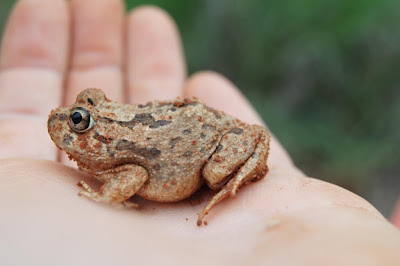On warm summer nights, much of our desert wildlife is at its most active and with the weather heating up, now is the perfect time to have a go at spotlighting. All you’ll need is a good torch or head lamp, a sturdy pair of walking shoes and a good patch of wildlife habitat, whether that’s your property or backyard, or whether you take a trip out bush.
Land for Wildlife coordinators were recently in Yulara and with footprint covered dunes and abundant spinifex seed surrounding the village, the temptation for a late night wander was too much to resist. The nights were quite cool, but clear, still and perfect for tracking down the creatures who’d left their prints all over the sand the previous night. Our hope was to spot some rarely seen night time geckos, such as the Knob Tails, that are not uncommon in the sand dune habitat. While the night was probably too cool for geckos, we did manage to view some other elusive Yulara residents.
Spinifex Hopping Mouse (Notomys alexis)
 |
| A juvenile Spinifex Hopping Mouse |
Hopping mice are mouse to rat sized rodents that are distributed throughout Australia. There are 10 species, although several are now extinct and two, the Darling Downs Hopping Mouse and Broad Cheeked Hopping Mouse are only known from skeletal remains.
The Spinifex Hopping Mouse however remains common, although populations fluctuate widely according to climatic and resulting food conditions. Their preferred habitat is sandy deserts on dunes and swales with spinifex, but they also occur in mulga country.
It seems that these mice are in a boom cycle around Yulara at the moment. Several were seen while spotlighting and although they couldn’t be examined closely to determine age and sex, they ranged considerably in size, suggesting that many juveniles were present in the population.
Their tracks criss-crossed the dunes around the resort, creating well-worn pathways between spinifex clumps, even in disturbed areas close to houses. And it seems they were making good use of introduced Buffel Grass as well as the spinifex.
Dunnart (Sminthopsis sp)
 |
| An unidentified Dunnart shelters under a spinifex clump |
Although superficially similar to a mouse, especially when seen from a distance crawling through grasses and ground vegetation, Dunnarts are quite different. Carnivorous marsupials, they hunt on warm nights for arthropods and small vertebrates. Their small, pointed jaws are packed with tiny, sharp teeth ideal for dispatching prey.
There are seven species that occur in central Australia, including the endangered Long Tailed and Sandhill Dunnarts. The remaining five species remain at least locally common in appropriate habitats. Dunnarts are difficult to identify without close inspection of an animal. The most reliable method is to examine the footpads on the soles of the hind feet – every species has its own unique arrangement of pads.































